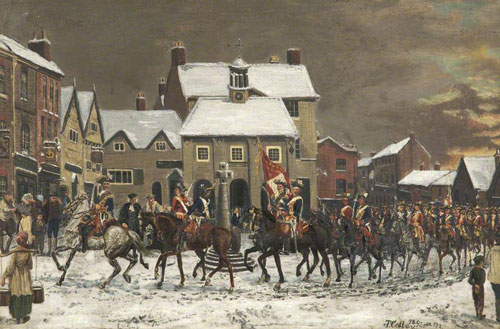WILDISH
Finally, here is an extract from the novel. It is a scene in Derby quite similar to that shown in the painting, though at dusk, in this instance, rather than dawn.
The cold evening air revives him straight away as he accompanies the footman the short distance across the market place and into the road where Exeter House is located - a stylish three-story mansion, set within a rectangular park and courtyard - the most substantial building in the area, in fact, other than the church with its tall, almost cathedral-like tower nearby. The snow must have been falling heavily, he notices, for it has settled with ease upon the roofs and cornices of the buildings, and it is very noisy everywhere, with the entire town most evidently full of soldiers, including many Highlanders - unmistakable in their distinctive plaid dress, some busy clearing away undergrowth to make space, pitching their field tents in gardens, others chopping firewood, cooking at campfires or else, with whet-stones in their hands, sharpening and maintaining their weapons, their swords and axes - the sparks flying sometimes in the darkness as they work. It is the first time Matthew has seen anything like it - all these battle-hardened soldiers, many of whom would have been on the march from one skirmish to the next for almost half a year. A good few of them have long, unshorn hair, and beards to match. They seem so strong; so powerful; so full of purpose and intent. The momentum is with them, these blood-hardened fighting men, anticipating each new confrontation, no doubt, with all the ease and practised skill that familiarity of warfare brings. Some stare across at him in his fine clothes as he and his escort proceed along the long, straight driveway up to the house, his blatant and provocative Englishness clear for all to see.

